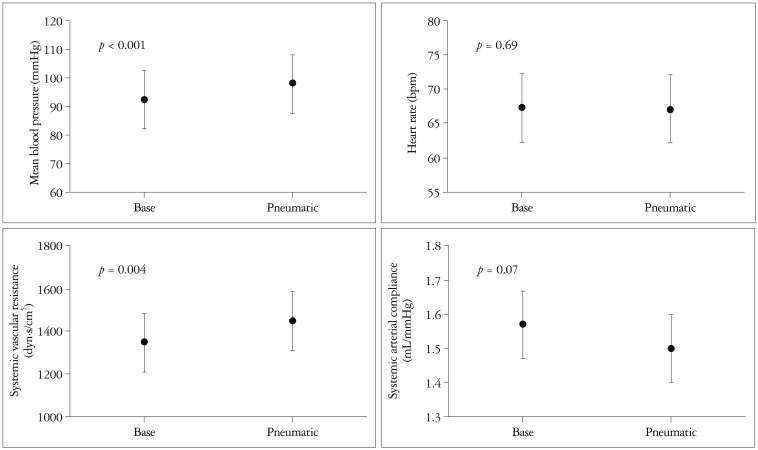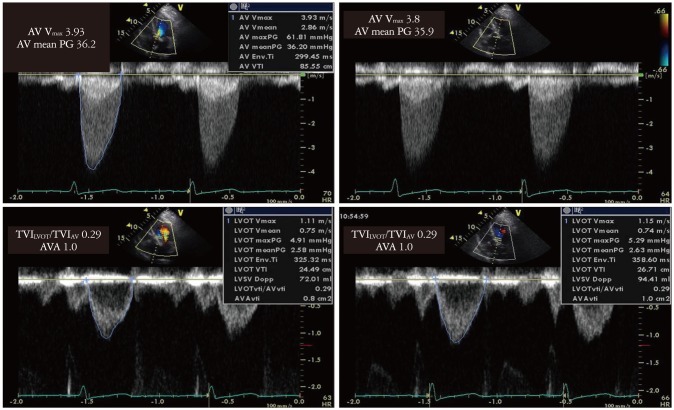J Cardiovasc Ultrasound.
2012 Jun;20(2):79-84. 10.4250/jcu.2012.20.2.79.
Impact of Afterload on the Assessment of Severity of Aortic Stenosis
- Affiliations
-
- 1Division of Cardiology, Department of Internal Medicine, Samsung Medical Center, Sungkyunkwan University School of Medicine, Seoul, Korea. elisabet.chang@gmail.com
- 2Cardiovascular Imaging Center, Cardiac and Vascular Center, Samsung Medical Center, Sungkyunkwan University School of Medicine, Seoul, Korea.
- 3Cardiac and Vascular Center, Seoul National University Hospital, Seoul, Korea.
- 4Department of Internal Medicine, Seoul National University College of Medicine, Seoul, Korea.
- KMID: 2177370
- DOI: http://doi.org/10.4250/jcu.2012.20.2.79
Abstract
- BACKGROUND
Aortic stenosis (AS) is increasingly diagnosed in current aging society. Echocardiography is the most important tool in the assessment of AS and its severity. However, load-dependency of Doppler measurement could affect the accuracy of AS severity assessment. We tried to evaluate the impact of afterload on the assessment of AS severity by modification of afterload using pneumatic compression (Pcom).
METHODS
Forty patients diagnosed as moderate or severe AS [effective orifice area of aortic valve (EOAAV) by continuity equation of < 1.5 cm2] were consecutively enrolled. Patients with severely uncontrolled hypertension, severe left ventricular (LV) dysfunction, and other significant valve disease were excluded. Comprehensive echocardiography was performed at baseline to assess AS severity. Then, pneumatic compression of the lower extremities by 100 mmHg was applied to increase LV afterload. After 3 minutes, echocardiography was repeated to assess AS severity.
RESULTS
Mean blood pressure was significantly increased under Pcom (p < 0.001), while heart rate remained unchanged. Peak aortic valve velocity (Vmax) was slightly, but significantly decreased under Pcom (p = 0.03). However, Doppler velocity index and EOAAV by continuity equation were not affected by Pcom.
CONCLUSION
AS severity assessment by echocardiography was not dependent on the change of LV afterload imposed by Pcom. AV Vmax was slightly decreased with LV afterload increment, but these changes were too small to alter treatment plan of AS patients. EOAAV and Doppler velocity index are more stable parameters for AS severity assessment.
Keyword
MeSH Terms
Figure
Cited by 1 articles
-
Problem Is in the Subclinical Afterload Mismatch
Eui-Young Choi
J Cardiovasc Ultrasound. 2012;20(2):77-78. doi: 10.4250/jcu.2012.20.2.77.
Reference
-
1. Faggiano P, Antonini-Canterin F, Baldessin F, Lorusso R, D'Aloia A, Cas LD. Epidemiology and cardiovascular risk factors of aortic stenosis. Cardiovasc Ultrasound. 2006; 4:27. PMID: 16813661.2. Lindroos M, Kupari M, Heikkilä J, Tilvis R. Prevalence of aortic valve abnormalities in the elderly: an echocardiographic study of a random population sample. J Am Coll Cardiol. 1993; 21:1220–1225. PMID: 8459080.3. Chambers J. Can high blood pressure mask severe aortic stenosis? J Heart Valve Dis. 1999; 8:277–278. PMID: 10399660.4. Hachicha Z, Dumesnil JG, Bogaty P, Pibarot P. Paradoxical low-flow, low-gradient severe aortic stenosis despite preserved ejection fraction is associated with higher afterload and reduced survival. Circulation. 2007; 115:2856–2864. PMID: 17533183.5. Antonini-Canterin F, Huang G, Cervesato E, Faggiano P, Pavan D, Piazza R, Nicolosi GL. Symptomatic aortic stenosis: does systemic hypertension play an additional role? Hypertension. 2003; 41:1268–1272. PMID: 12707297.6. Park HE, Chang SA, Kim HK, Shin DH, Kim JH, Seo MK, Kim YJ, Cho GY, Sohn DW, Oh BH, Park YB. Impact of loading condition on the 2D speckle tracking-derived left ventricular dyssynchrony index in nonischemic dilated cardiomyopathy. Circ Cardiovasc Imaging. 2010; 3:272–281. PMID: 20190282.7. Otto CM, Pearlman AS, Comess KA, Reamer RP, Janko CL, Huntsman LL. Determination of the stenotic aortic valve area in adults using Doppler echocardiography. J Am Coll Cardiol. 1986; 7:509–517. PMID: 3950230.8. Ihlen H, Amlie JP, Dale J, Forfang K, Nitter-Hauge S, Otterstad JE, Simonsen S, Myhre E. Determination of cardiac output by Doppler echocardiography. Br Heart J. 1984; 51:54–60. PMID: 6689921.9. Mascherbauer J, Fuchs C, Stoiber M, Schima H, Pernicka E, Maurer G, Baumgartner H. Systemic pressure does not directly affect pressure gradient and valve area estimates in aortic stenosis in vitro. Eur Heart J. 2008; 29:2049–2057. PMID: 18502739.10. Thubrikar M, Bosher LP, Nolan SP. The mechanism of opening of the aortic valve. J Thorac Cardiovasc Surg. 1979; 77:863–870. PMID: 439922.11. Higashidate M, Tamiya K, Beppu T, Imai Y. Regulation of the aortic valve opening. In vivo dynamic measurement of aortic valve orifice area. J Thorac Cardiovasc Surg. 1995; 110:496–503. PMID: 7637367.12. Little SH, Chan KL, Burwash IG. Impact of blood pressure on the Doppler echocardiographic assessment of severity of aortic stenosis. Heart. 2007; 93:848–855. PMID: 17135222.13. Rubal BJ, Geer MR, Bickell WH. Effects of pneumatic antishock garment inflation in normovolemic subjects. J Appl Physiol. 1989; 67:339–345. PMID: 2759962.14. Abbas AE, Fortuin FD, Patel B, Moreno CA, Schiller NB, Lester SJ. Noninvasive measurement of systemic vascular resistance using Doppler echocardiography. J Am Soc Echocardiogr. 2004; 17:834–838. PMID: 15282486.15. Chemla D, Hébert JL, Coirault C, Zamani K, Suard I, Colin P, Lecarpentier Y. Total arterial compliance estimated by stroke volume-to-aortic pulse pressure ratio in humans. Am J Physiol. 1998; 274(2 Pt 2):H500–H505. PMID: 9486253.
- Full Text Links
- Actions
-
Cited
- CITED
-
- Close
- Share
- Similar articles
-
- Multimodality Imaging for the Assessment of Severe Aortic Stenosis
- A Study of the Assessment of Left Vertricular Function in Non-Rheumatic Aortic Stenosis after Aortic Valve Replacement
- Unicommisural Unicuspid Aortic Valve with Very Severe Aortic Stenosis in a 17-Year-Old Female
- Assessment of Afterload by Doppler Aortic Flow Velocity Measur ement
- A Case of Supravalvular Aortic Stenosis



